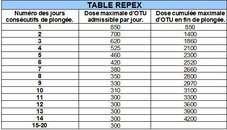packrat12
Contributor
Stuartv,
This is where experience is important to understand what you are reading. Yes, no one has said it cannot be done. But....
Let us look at this from a logical point. The Max NOAA PPO2 is 1.4 for recreational diving. Period. Any contingency planning that goes above needs to have the mix altered. For the sake of argument I will ignore ½ O2 wash out.. I use .7 ft3/min as a normal calculation for air consumption for the average person. All of my numbers are rough.
PPO2 @ 1.4 = 150 minutes exposure. For sake of argument, we will do 80% = 120 minutes.
Highest mix for recreational = 40%
Shallowest depth of 1.4 = 80’ (1.4 @ PPO2=40)
Total dive time required = 120 minutes.
Max NDL at 80: 74 min
After a 6hr SI NDL at 80: 46 min
Gas required = 3.4ATA * .7 = 2.4 ft3/min at depth * 120 = 288 ft3 = 3.75 (80ft3 tanks) without any reserve to fully drained.
This is one heck of a dive! Over 4 -80's in one recreational day diving.... whew! Still does not reach CNS of 100%, only 80% which is recommended. Does not include the CNS wash out either. The above is very sloppy but gives an idea of the extreme profiles that must be done to achieve CNS O-tox while on a recreational profile. I will accept that there can be errors also and will very much entertain that fact. This is a very rough calculation.
This is where experience is important to understand what you are reading. Yes, no one has said it cannot be done. But....
Let us look at this from a logical point. The Max NOAA PPO2 is 1.4 for recreational diving. Period. Any contingency planning that goes above needs to have the mix altered. For the sake of argument I will ignore ½ O2 wash out.. I use .7 ft3/min as a normal calculation for air consumption for the average person. All of my numbers are rough.
PPO2 @ 1.4 = 150 minutes exposure. For sake of argument, we will do 80% = 120 minutes.
Highest mix for recreational = 40%
Shallowest depth of 1.4 = 80’ (1.4 @ PPO2=40)
Total dive time required = 120 minutes.
Max NDL at 80: 74 min
After a 6hr SI NDL at 80: 46 min
Gas required = 3.4ATA * .7 = 2.4 ft3/min at depth * 120 = 288 ft3 = 3.75 (80ft3 tanks) without any reserve to fully drained.
This is one heck of a dive! Over 4 -80's in one recreational day diving.... whew! Still does not reach CNS of 100%, only 80% which is recommended. Does not include the CNS wash out either. The above is very sloppy but gives an idea of the extreme profiles that must be done to achieve CNS O-tox while on a recreational profile. I will accept that there can be errors also and will very much entertain that fact. This is a very rough calculation.




